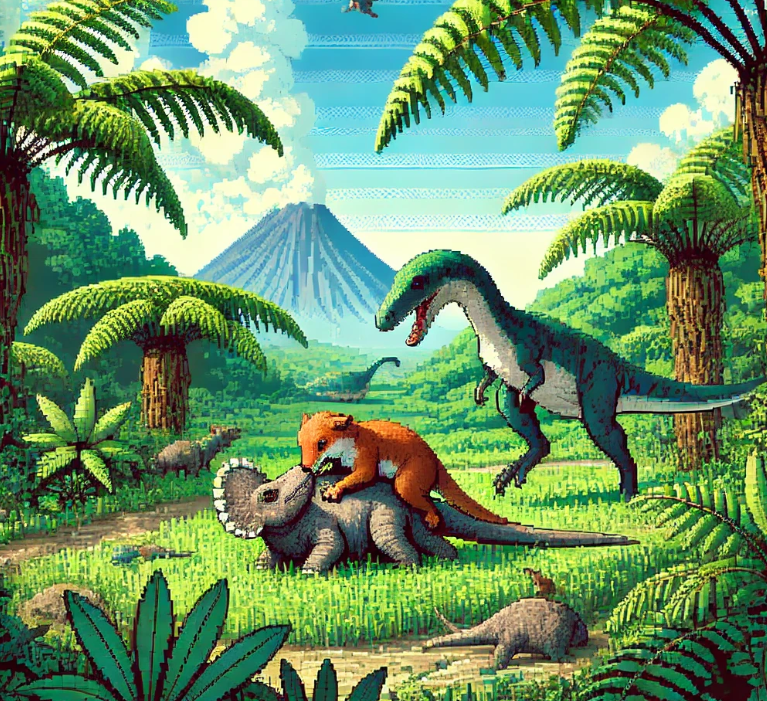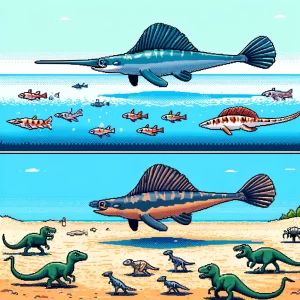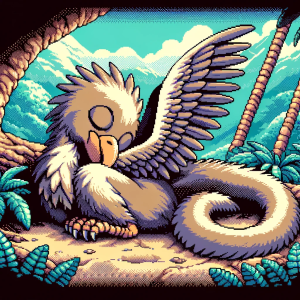
The Day a Mammal Took Down a Dinosaur
In the quiet, ancient world of the Cretaceous period, two unlikely foes met in a deadly struggle, their fierce battle immortalized forever in stone. On one side, a small but tenacious mammal, Repenomamus robustus, and on the other, a young, yet formidable dinosaur, Psittacosaurus lujiatunensis. This is not a scene from a Jurassic Park movie, but a real fossil find that has left paleontologists in awe—and rethinking everything we thought we knew about life in the Mesozoic era.
This remarkable discovery, unearthed from the Lujiatun Member of the Yixian Formation in China, reveals a story frozen in time: a mammal locked in mortal combat with a dinosaur, challenging our long-held belief that mammals were always the underdogs in the age of the dinosaurs. But this fossil shows that underdogs sometimes win—or at least put up one heck of a fight.
A Snapshot in Time: The Fossil That Changed Everything
Imagine a world where dinosaurs ruled, their colossal forms dominating the landscape. And yet, in this world, tiny mammals were not simply hiding in the shadows, as previously thought. The fossil in question captures an intense moment, a predatory mammal attacking a dinosaur, suggesting that mammals might have been more daring than we’ve ever imagined.
The fossil was found in an area known for its rich deposits of ancient life, often referred to as the “Chinese Pompeii” due to the preservation of fossils in volcanic ash. These deposits have given us some of the best-preserved snapshots of life from over 125 million years ago. The Yixian Formation, in particular, has been a treasure trove, revealing a wide array of small-bodied dinosaurs and other creatures, all caught in the act of living—or dying.
The story begins with a sudden volcanic eruption, the kind that buried entire ecosystems in an instant. Among the victims of this natural disaster were our two combatants: Repenomamus, a mammal about the size of a modern house cat, and Psittacosaurus, a dinosaur roughly the size of a large dog. The two were locked together, the mammal’s teeth embedded in the dinosaur’s ribs, its hand gripping the dinosaur’s jaw. They were buried together, preserving their final struggle for millions of years.
Rewriting the Story of Mammals and Dinosaurs
For decades, the narrative has been that mammals during the Mesozoic era were small, timid creatures, eking out a living while staying clear of their dinosaur overlords. After all, dinosaurs were the dominant life forms, with mammals only rising to prominence after the dinosaurs’ extinction. But this fossil tells a different story, one where mammals were not just passive players in the dinosaur-dominated world but active participants in the ecosystem, sometimes even challenging the dinosaurs themselves.
The fact that Repenomamus was found in such a dramatic pose, with its jaws clamped onto a dinosaur, suggests that it was attempting to take down the Psittacosaurus, possibly as a predator. This challenges the assumption that Mesozoic mammals were strictly scavengers or insectivores. Instead, this mammal appears to have been a predator, not afraid to take on prey larger than itself.
This discovery forces us to rethink the dynamics of Mesozoic ecosystems. If mammals were capable of preying on dinosaurs, even if only on the smaller species or juveniles, it suggests that these ecosystems were far more complex than previously thought. It also raises intriguing questions about the evolutionary pressures that shaped these early mammals, possibly pushing them towards behaviors that would eventually lead to the rise of larger, more dominant mammalian predators after the dinosaurs’ extinction.
The Volcano’s Deadly Embrace: How a Lahar Preserved the Battle
But how did these two creatures end up preserved in such a dramatic scene? The answer lies in the nature of the Lujiatun Member’s fossil deposits. The area was prone to volcanic activity, and it appears that these two creatures were caught in a sudden lahar—a fast-moving flow of volcanic debris that buried everything in its path.
The fossilized remains show no signs of having been transported over a long distance, meaning that they were likely buried where they died. The volcanic ash and debris acted like a natural casting material, preserving not just the bones but the very positions of the animals as they struggled. This type of fossilization, known as obrution, is rare and offers an unparalleled glimpse into the behavior of ancient creatures.
The entwined skeletons tell a story that could not have been forged. Their positions, with the mammal perched on top of the dinosaur, biting into its ribs, suggest that Repenomamus was actively attacking the Psittacosaurus when the volcanic flow hit, freezing them in this moment of life—and death.
Why This Matters: Changing the Way We See Evolution
This discovery is more than just a cool fossil find; it’s a game-changer for our understanding of evolutionary history. It challenges the long-standing view of mammals as insignificant during the age of dinosaurs, suggesting instead that they played a much more active role in their ecosystems. This has implications for how we understand the evolution of mammals, particularly in the context of their survival and eventual dominance after the dinosaurs’ extinction.
It also highlights the importance of the fossil record in revealing the complexities of ancient life. Each new find adds a piece to the puzzle, sometimes reinforcing our existing theories, but often, as in this case, forcing us to rethink them. The Lujiatun fossil is a stark reminder that nature is full of surprises, and that our understanding of the past is always evolving.
As we continue to uncover more fossils like this one, our picture of the Mesozoic world—and the role of mammals within it—will only become clearer. For now, this fossil stands as a testament to the tenacity of life, showing that even in a world dominated by giants, the small and seemingly weak can sometimes have the last word.
Join the Conversation: What Do You Think?
What does this discovery tell us about the nature of predation in ancient ecosystems? Could there be more examples of mammals taking on dinosaurs that we haven’t yet found? Share your thoughts in the comments below!
Join the Science Adventure:
Stay updated with the latest discoveries in science! Our weekly newsletter is perfect for teachers and science enthusiasts. Get the newest research, major breakthroughs, and fascinating stories delivered to your inbox for free. Enhance your teaching and learning. Subscribe today! If you liked this blog, please share it! Your referrals help This Week in Science reach new readers.



